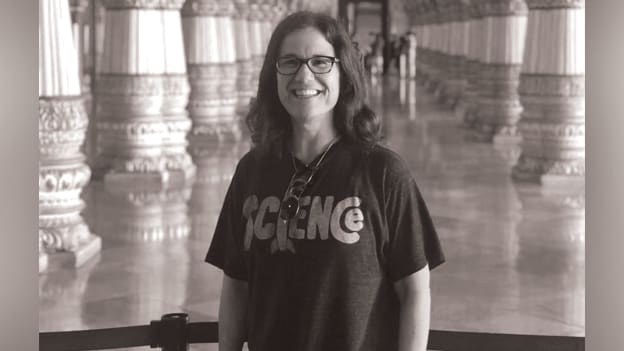Hire for skills and values: Amy Zimmerman, Global Head of People Operations, Kabbage

As a social worker at heart, Amy Zimmerman was in the business of helping people. That was before she realized that helping people get the right job was something that she enjoyed doing and happened to be good at.
Founded in 2008, Kabbage is a startup that helps small and medium businesses get automated funding. As an online lending platform, the engineers and data scientists on the team help leverage data from the enterprise’s online sales, shipping, accounting data, and other performance-related information in order to provide real-time funding.
With more than 20 years of experience in helping organizations find, grow, and keep talent, Zimmerman is tasked with nurturing the company’s culture across a global team with four locations within the United States and one in Bangalore, India.
The Kabbage team invests heavily in technology and thus are constantly seeking out individuals who are innovators and disruptors in the technology space. In an exclusive interaction with People Matters, Amy Zimmerman, Global Head of People Operations, Kabbage, shared her insights on the role of technology in hiring, acquiring people with the right skills and values and designing a value-driven culture in the workforce.
Describe your journey as a business leader and how you transitioned into the role of Global Head of People Operations at Kabbage.
The idea of coaching people professionally and helping them discover and then pursue their passion was really exciting for me. As a social worker, I’ve always wanted to help people. When I moved to Atlanta from Florida, I joined a small, but growing tech company as a recruiter. That role quickly evolved so I started handling onboarding, benefits, and employee relations. As is customary in small scrappy start-ups, I wore multiple hats and learned the ropes fast, organically. My natural curiosity and knack for connecting with people proved invaluable as conflicts arose and I helped navigate them directly/transparently. The other leaders began referring to me as the “glue”. That company was eventually acquired and I remained with the large acquirer for a couple of years before going out on my own and starting a consulting business. Over the next several years, I assisted dozens of companies with their recruiting, culture, org design, and engagement/retention initiatives. When Kabbage was founded, they became a client. I enjoyed working with the founders and loved the mission so much, that a couple of years later, I sunsetted my practice to join them full time.
What are some of the new technologies that could help TA leaders stay ahead of the curve when it comes to hiring for the future of work?
It is easy to get distracted by technology--particularly in HR. You’ve got to focus on the basics--connecting with people. Technology such as AI can definitely make the work more efficient! Evaluating resumes to understand the skills that a potential candidate possesses can certainly be done using AI. It will not only save the manager’s time but also eliminate the chances of human error to a great extent. However, completely replacing the human touch with technology is not wise--especially when it comes to talent acquisition.
What role does candidate experience play, in your opinion, when it comes to not only hiring the right talent but also creating a talent source pool?
Successful talent acquisition is based on building relationships. It starts with the very first communique that goes out to the candidate. The recruiter makes a connection, they start building a relationship with the candidate who picks up on the vibe, energy and the culture of the company. Let’s face it, most of us work more upwards of 50 hours a week! It is important that you enjoy the work that you do and you work with people who you get along with and who can help you grow.
The first impression about the company that any candidate will have is based upon their interaction with the TA leader or recruiter. It is crucial to understand the candidate experience and how they felt about the interview process. It is really important for me that we take those candidate surveys AFTER a final decision has been made. At Kabbage, we ask for feedback from every candidate who has reached the face-to-face interview stage. There is no substitute for the people experience.
I have challenged all the recruiters at Kabbage to concentrate on the candidate experience like never before. Let the decision of whether to hire or not to hire be the managers’ dilemma. Let’s make sure that any candidate with the right skillset who comes in for the interview is so happy that they want this job more than they’ve wanted any other job in their entire lives! And, if we decide to go in a different direction at the time, it is important to be respectful and professional. Perhaps, at this point in time, you as a recruiter are unable to hire them, however, inadvertently, you are creating your talent pool for the future right there!
In a world where the demands of the business keep changing with each passing day and job descriptions change the moment a new employee walks in through the door, how do you actually go about the process of identifying the skills required for a particular role, finding the right person to do the job and in-turn hiring and retaining them?
There are a couple of things that I would look for--skills and values. Some technical skills are defined by the education but there are many more that are dictated by the kind of experiences the particular candidate has been exposed to. As an organization, it is important to identify and analyze which skills are working and which aren’t. At Kabbage, we’ve identified a success criteria for our work environment and we’ve woven that element into our interview process so that when the teams are evaluating candidates, they know the types of individuals or the types of characteristics it takes for somebody to be successful in the company.
The other critical element is values. Values are something that all companies talk about. Some companies tell you that their values are the holy grail. Their values are sometimes posted on their wall for all to see. However, that doesn’t mean that those values get translated into actions. Instead of creating the company values from scratch that the team members are not able to connect with, an employee-first approach is the answer! Interacting with team members and high-performing teams to observe the behaviors of the ones most successful, to identify the values that drive them, is crucial. Caring deeply for our people and customers is one of our core values. To that end, the value of care reflects through our behavior and all of our practices as well. We’ve even fired people who were brilliant engineers for demonstrating repeated disruptive behavior in the workplace.
What are the top three metrics that you would recommend TA leaders use when it comes to measuring the impact on business performance?
How much time it takes to fill a role is a major indication of the impact you are making as a TA leader. Other factors include, the quality of the candidate, if hired, getting feedback about their onboarding experience based on continuous surveys. It is important to ask new team members questions such as does the work that they are performing now that they are hired to match up to the expectations set at the beginning of the interview process. Surveys to solicit feedback definitely work for us! We launch the first survey after a month of the new hire joining the organization and the next one is conducted after 90 days. Another measure we look for is whether they are working for the company even after a year.
Through such metrics, TA leaders can identify trends and patterns within the organization. Perhaps there is a particular job role that sees a lot of turnover or there might be a mismatch in what the job description says and the nature of the day-to-day work. Moreover, there could also be a misalignment of skills!
Once you identify these patterns, then it is only a matter of time until you get the right recruiting strategy in place. With the right employer brand message along with consistent course-correction, TA leaders can definitely transform their new-age hiring practices to gear up for the new wave of technological and digital disruption that is facing us all in the workplace.













